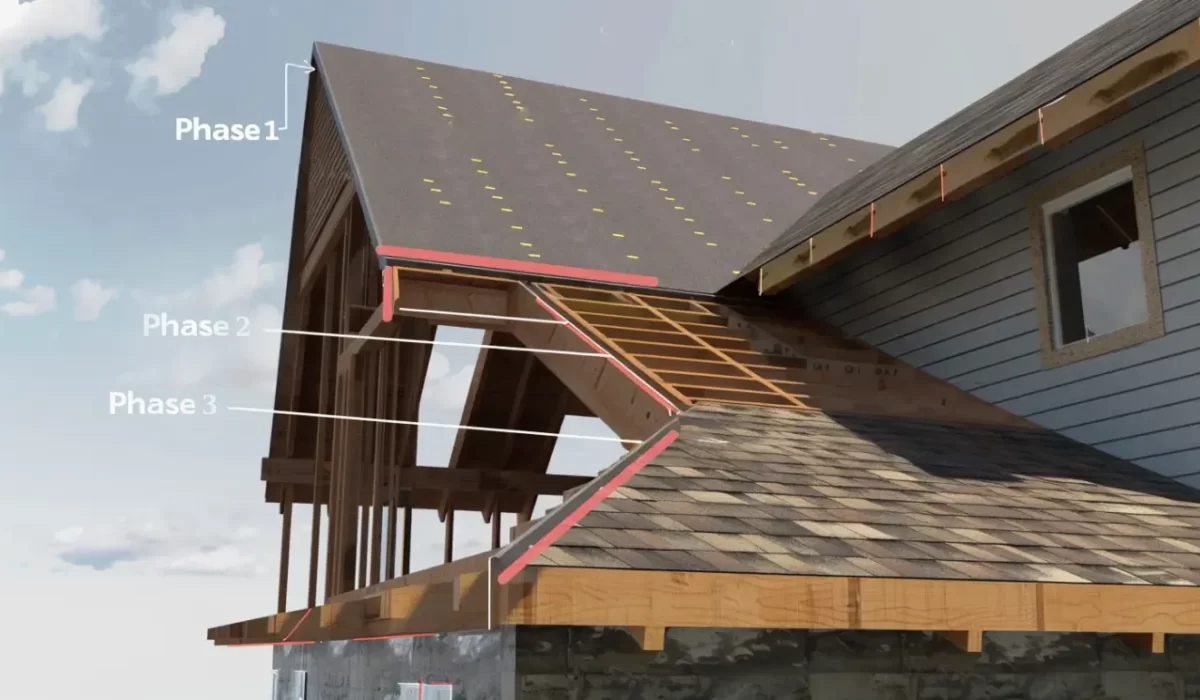Planning a roof replacement for a commercial property takes more than simply tearing off old shingles and adding new ones. For Orange County, CA property managers and HOAs, phased roof replacements supported by proper planning offer increased protection, minimize operational disruptions, and ensure continued business function throughout the project. With Fontaine Roofing’s decades of expertise and commitment to quality, commercial roofing projects are managed to achieve optimal outcomes, utilizing industry-leading materials and a strategic approach that stands up to the test of time.
How to Plan a Phased Roof Replacement
Laying the groundwork for a successful phased roof replacement starts with careful planning and a thorough understanding of the existing roof’s condition. Property managers must collaborate with their roofing partner to assess the scope of the roofing project and outline project milestones before any work begins. This proactive planning phase helps anticipate potential challenges, define priorities, and ensure each section of the roof receives the attention needed for a secure, long-lasting installation. Next, let’s explore what detailed assessment looks like and how to establish a strategic phasing plan.
Contact Us
Assessing Roof Conditions and Project Scope
A successful roof replacement begins with a thorough assessment of the roof structure and deck. Fontaine Roofing’s experts conduct detailed inspections to identify potential damage from weather or aging, examining all layers—flat or metal—for water infiltration, loose nails, and underlying issues.
Following the inspection, we provide tailored recommendations for repairs or replacements based on the building’s specific needs. This review helps property managers efficiently allocate resources and schedule work. Best practices include segmenting the roof, addressing each section individually, and ensuring watertight integrity before proceeding. Careful attention to detail mitigates risks and extends the new roof’s lifespan.
Commercial Property Project Phasing Strategies
A robust strategic plan is essential for phased roof replacements in commercial buildings. Fontaine Roofing partners with property managers and HOAs to manage projects efficiently and select contractors, minimizing disruptions while ensuring high-quality installations. The phased replacement schedule includes a roof assessment, followed by section-by-section removal and replacement during off-peak hours. Key milestones involve completing sections, debris removal, and final walkthroughs. Important activities include stakeholder communication, coordinating material deliveries, and ensuring compliance with local building codes. By collaborating with top manufacturers like Polyglass, GAF and CertainTeed, Fontaine Roofing guarantees efficient and secure phase completions.

Limiting Disruptions During Projects
Managing business operations during a phased roof replacement demands careful planning to minimize disruptions for tenants and stakeholders. Fontaine Roofing works closely with property managers, using effective communication and precise scheduling to keep businesses running smoothly throughout the project. Scheduling roof work during off-peak hours and providing regular updates help maintain tenant satisfaction and protect commercial property value. Next, let’s examine how scheduling strategies and communication methods further reduce the impact on daily activities.
Scheduling Work to Reduce Impact on Tenants
Effective scheduling is vital for minimizing disruptions during phased roof replacements. By planning strategically, property managers can conduct work during off-peak hours, allowing tenants to maintain daily operations with minimal interference. Coordination with the roofing contractor ensures that installation aligns with business activities, enhancing operational efficiency.
Advance communication of the project timeline fosters transparency and prepares tenants for potential inconveniences. Staggered work schedules allow specific roof sections to be addressed at a time, facilitating smoother transitions between phases. This careful planning safeguards the existing roof’s integrity while promoting tenant satisfaction throughout the project.
Communication Tips for Managers and Stakeholders
Clear communication is vital for successful phased roof replacements. Property managers should maintain ongoing dialogue with stakeholders, keeping everyone informed about the project’s scope, timelines, and expectations. Modern tools like project management software can enhance transparency and address concerns about daily disruptions.
Regular updates on the roof deck’s condition and phasing plan adjustments are crucial. Encouraging tenant feedback fosters collaboration and emphasizes their comfort and safety during significant projects. Proactive communication builds trust, cooperation, and helps ensure structural integrity and quality throughout the replacement process.

Safety Measures During Each Phase
Implementing robust safety measures during every stage of a phased roof replacement protects both workers and building occupants. Fontaine Roofing strictly adheres to building codes and industry standards, ensuring job sites remain secure and all activities meet high-quality benchmarks. Safety standards are integrated into the project management plan, encompassing everything from fall protection to water infiltration safeguards. Next, let’s detail how workers and occupants remain protected and how compliance with Orange County regulations supports project success.
Safety for Workers and Occupants
Ensuring safety during a roof replacement is crucial for both workers and occupants. Start with a thorough inspection of the roof deck to identify hazards like loose nails or structural issues. A phased approach minimizes disruption while prioritizing safety.
Effective communication is key to raising safety awareness. Regular briefings keep everyone informed about operations, project phases, and risks. Proper planning and adherence to local building codes are vital for a secure working environment, safeguarding the roofing system and its occupants.
Meeting Orange County Codes and Industry Standards
Meeting Orange County’s building codes and roofing standards is vital for phased roof replacements. As a Polyglass Preferred and GAF Master Elite Contractor, CertainTeed Shingle Master, Fontaine Roofing excels in materials, installation, and safety. Our credentials as an IB Roofing Systems Authorized Applicator and TRI certified contractor showcase our expertise. Memberships in CACM, CAI, and NRCA reflect our commitment to high standards. Final inspections ensure compliance while we effectively manage challenges like waste and weather. By engaging certified contractors knowledgeable about code changes, we minimize risks. With our strict adherence to standards, property managers and HOAs in Orange County, CA can enjoy peace of mind and durable roofing solutions.
Connect With Us
In conclusion, successful phased roof replacements in Orange County, CA, require careful planning and execution. By assessing roof conditions, creating a strategic phasing plan, and minimizing disruptions, property managers can ensure smooth operations and occupant satisfaction. Adhering to safety measures and local regulations is essential for project success. At Fontaine Roofing, our expertise and certifications allow us to manage commercial roofing complexities effectively. For professional guidance on your phased roof replacement in Orange County, contact us for a consultation. Your property’s integrity and occupant comfort are our top priorities.
Read our blog: Planning Quiet Roof Upgrades Without Disturbing Occupants
Frequently Asked QuestionsAs.
How does a phased approach affect project costs and timelines?
A phased approach can spread project costs over time and allow better control of timelines. While the entire roof is replaced gradually, business operations experience fewer disruptions. Costs may be higher per phase due to mobilization, but careful planning ensures budget and schedule alignment for property managers.
What best practices ensure successful coordination throughout each phase?
Proper planning, detailed roof installation schedules, ongoing communication, and rigorous safety measures are essential for successful phased roof replacements. Experienced project management, frequent inspections, and stakeholder updates support smooth transitions and ensure quality standards are consistently met through every step of the process.

